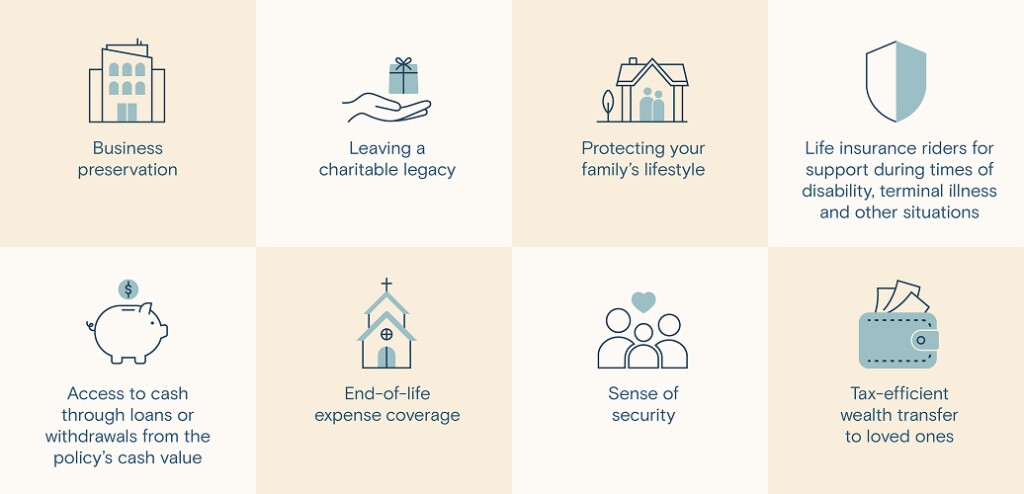When you apply for life insurance, you're looking for a sustainable premium and a reliable death benefit. These features can reassure you and your family that they'll be protected financially after you pass away. But certain life insurance risk factors can make it more difficult to qualify for coverage at an affordable rate.
As you prepare your application, you'll want to know what insurers view as high risk. To secure the
Who's considered a high-risk life insurance applicant?
During the
The insurer looks at the risks that may come with that: They might collect premium payments for a shorter period and pay a death benefit sooner. This could put financial strain on the insurer and, if not properly managed, damage their ability to pay claims.
To account for that possibility, high-risk applicants will have to pay higher premiums or, sometimes, may not be approved at all. Insurers may also limit the types of policies and coverage amounts available to these applicants.
What are the life insurance risk factors?
To estimate your life expectancy, insurers will consider your age, medical condition and lifestyle, including your occupation and any risky hobbies.
Medical & health risks
Health problems or medical conditions that negatively affect your life expectancy, or a family history of these conditions, could indicate an increased risk. Some common examples include:
- Cancer. A diagnosis or history of cancer is likely to place you in the high-risk category, although insurers consider the type of cancer and your prognosis.
- Diabetes. Diabetes is a risk factor, but if you can control it with medication, diet and exercise, you can reduce its impact on your rate.
- Heart conditions. If you've had a heart attack or were diagnosed with other heart problems, you'll likely be classified as high risk.
- Obesity. Your general level of health, including your weight, is also a factor. Each insurer has their own guidelines, but generally a body mass index above 30 is the threshold.
- Tobacco and alcohol use. Insurers tie tobacco and alcohol to an increased risk of certain diseases and medical conditions. Using either of these products can cause your premiums to go up.
High-risk hobbies
During the evaluation process, you'll be asked questions about your hobbies and activities. If you engage in high-risk activities, you'll likely pay higher premiums. Each insurer has their own criteria, but examples could include drag racing, riding motorcycles, bungee jumping and skydiving.
Dangerous occupations
Insurers consider some jobs more dangerous than others, and this could affect your application and premium. Law enforcement, operating heavy machinery and construction work may all be considered high-risk occupations, for example.

How much life insurance do you need?
Risk classifications for life insurance
Based on your application, the insurer will assign you a risk category to determine your eligibility and premium. The better your risk class, the lower your premium will be.
The number and classification of risk categories vary by insurer, but all follow a similar general theme:
- Preferred Best or Preferred Select. These applicants are lowest-risk, with virtually no negative indicators in their family history, personal health or lifestyle. As such, they will receive the best rates.
- Super-Preferred. These applicants have minimal risk factors, but not quite rated as best.
- Preferred. These are generally healthy applicants with minimal risk factors.
- Standard. Applicants who have a few risk factors, such as a dangerous job or a few mild health conditions, may be placed in this category.
- Preferred Tobacco. These are applicants who would otherwise qualify as preferred, but who use tobacco.
- Standard Tobacco. Applicants who would otherwise qualify as standard, but who use tobacco, fall into this category.
- Substandard or Rated. This is where many insurers place high-risk applicants. Premiums are significantly higher for those in this category, which may be further divided between tobacco and non-tobacco.
Types of life insurance for high-risk applicants
The same
Group life insurance
It's common for employers or trade associations to negotiate lower rates than what you may be able to get on your own, including life insurance specifically for people with high-risk jobs. If occupational risk is a factor, you may be able to receive coverage in a group specific to your profession. You may not even need a medical exam; these are typically only required when applicants request more coverage.
Term life insurance
However, term life may or may not be a good option depending on why you're deemed high risk. You may only qualify for a minimal amount of coverage, which may not be enough to
Investment strategy
If you are denied coverage, consider saving the money you would otherwise pay toward insurance premiums into savings and investments. In addition to an
Finding the right life insurance for you
While high-risk applicants may face challenges when they apply for life insurance, a fair contract is still within reach. If you're denied coverage or the premium is too high, you can apply with other insurers—not every company assigns the same level of risk, charges the same cost, or views applicants simply based on their assigned classification.
A







